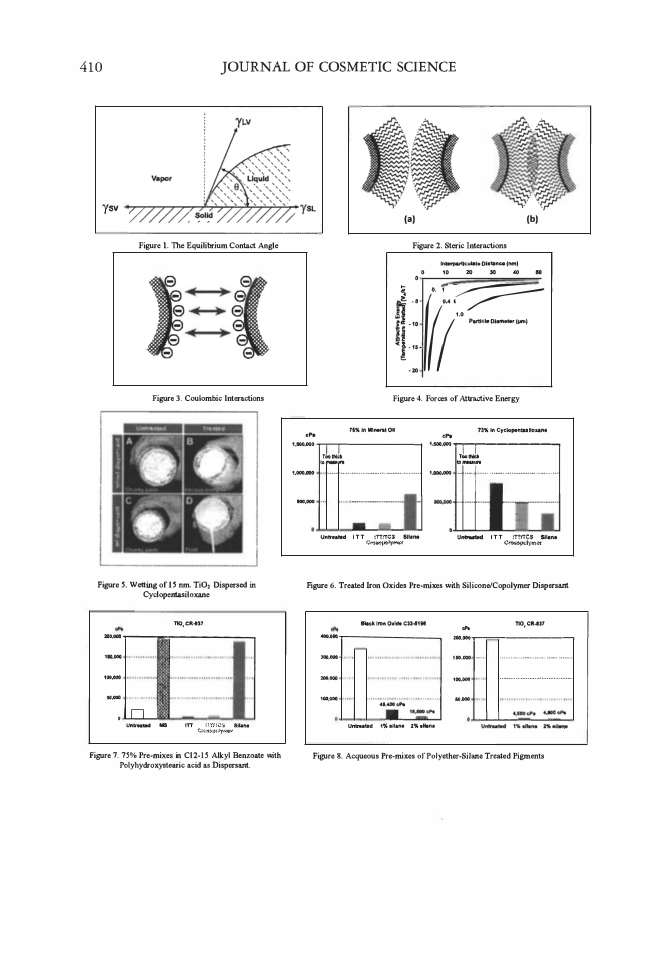2004 ANNUAL SCIENTIFIC SEMINAR 409 diminished. The attractive energy arises from Van der Waal's forces. Thus, the thickness of the adsorbed layer necessary for the effective stabilization of the dispersed particles increases with increasing particle sizes as shown in Figure 4 (8,9). According to theoretical calculations, dispersions of micronized pigments with particle sizes under 0.2 microns should require a thinner layer than dispersions of pigmentary grades or other filler particles greater than 1 micron. Apnlications of Dispersion Technologv In practice, most of the inorganic particulates contained in cosmetic formulations have highly polar surfaces that are hydrophilic, and are poorly wetted by organic carriers with low to medium polarity such as cyclopentasiloxanes, hydrocarbons and esters. Organic surface treatments like alkoxy titanates, silanes, methyl polysiloxanes, and alkoxy dimethicones are all known to react with and displace the air and water of hydration absorbed on a pigment surface, rendering it from hydrophilic to hydrophobic or lipophilic. We compared the importance of the surface treatment to the dispersant to pre-wet a 15 nanometer micronized titanium in cyclopentasiloxane in Figure 5. (10) Further, we developed a novel crosspolymer surface treatment to promote the wetting of pigments in multimedia. Fi gu re 6 shows the viscosity of treated iron oxide pre-mixes in mineral oil and cyclopentasiloxane. Fi gu re 7 shows the viscosity of a treated rutile titanium dioxide pre-mix in an ester. (11). Cosmetic dispersions are also made in hydrous (water, polyhydric alcohol) systems. Ammonium and sodium polyacrylates have been found to be important dispersing aids, acting to swell the particles water layer and put a stabilizing charge on their surface. According to our study, reactive polyether silanes may also be employed to enhance wetting in aqueous systems. Viscosity data for iron oxide and titanium dioxide premixes can be found in Figure 8 (11). Lastly, we compared the wetting of branched dimethicone treated rutile titanium dioxide in cyclopentasiloxane to popular hydrophobic treatments in Figure 9 by measuring their pre-mix viscosities. (11 ). Table I lists the viscosity and particles sizes of four dispersions containing a 14 nn1. methicone treated micro titanium dioxide that we compared (12). The wetting was best when polyhydroxystearic acid was used as the dispersant in isododecane. All the dispersions were stable at 50°C for one week. Experiments were made dispersing inorganic ultraviolet filters with primary particle sizes ranging from 10 to 200 nm. in silicone fluids, hydrocarbons and esters with various surface treatments and dispersants. The dispersion particle sizes were recorded and compared to their primary particle size. An index of agglomeration was calculated as the ratio of the dispersion particle size over the primary particle size (12). The data presented in Table 2 is representative of the samples prepared and shows that pigments having a smaller primary particle size contain larger indices of agglomeration. Thus, smaller primary particles are harder to disperse. We have found that adding bentonite clays, fumed silica, synthetic waxes, and polysaccharides can thicken dispersions to reduce syneresis and improve suspension of pigments and actives. Evaluation of Pigment Dispersions Both science and art play a role in dispersion testing. Twenty-five years ago the plant manager could approve a batch of nail laquer by observing the way it ran off his blade. Nowadays, viscosity samples are mixed with a mechanical mixer and incubated before testing on an instrument such as a Brookfield RVT. Draw downs are still compared by operators at various stages during processing on cards or glass plates to study transparency, color, drying time and gloss, however, greater reliance is placed on instrun1ents. An example is the particle size which is often measured by using a light scattering size analyzer. Nevertheless, it is an art to measure the size correctly, as the powder or dispersion san1ple must be diluted and sonicated to a usually low concentration in an appropriate solvent. Imaging technologies will play a greater role in evaluating dispersions in the future. Ono, et al measured particle sizes of novel dispersions of cellulose particulates with both a light scattering size analyzer and an electron microscope and calculated a coefficient of aggregation of 1.0 to 3.0 (13). Willian1s, et al. patented a microelectrical resistance tomography system comprising one or more sensors to characterize flowing dispersions including particle shape and size. Summarv The conditions to wet pigments were shown to influence their pre-mix viscosity and the dispersion particle size. Silicone/copolymers and polyhydroxystearic acid are effective stabilizers for pigment dispersions. The stability of dispersions could be improved by decreasing their particle size as the theoretical models predict. More work needs to be done to quantify the differences between the dispersions in order to learn more about their behavior and to predict their performance in finished products.
410 JOURNAL OF COSMETIC SCIENCE ysv Figure l. The Equilibrium Contact Angle Figure 3. Coulombic Interactions Figure S. Wetting of IS nm. Ti02 Dispersed in Cyclopentasiloxane TIO,CR-137 2110,000�----------- 1SO,OOO 100,000 51,000 .LO_ Untrnwd MS ITT ::·a:,�::. &Hane !' :,:-,:,.:);.::yfR!o:' Figure 7. 75% Pre-mixes in Cl2-15 Alkyl Benzoate with Polyhydroxystearic acid as Dispersant. (a) (b) Figure 2. Steric Interactions lntarpartlc 11i.t• Dlalan"" (nml 0 10 20 30 40 118 �· ···�0 r Vi!.4 1 · 0 ParticleDlame18r(llftl) o(t•f5• t::. -20 Figure 4. Forces of Attractive Energy 7$% In Mineral OH 13% In Cyclo.,.ntullouno GP8 1,soo,000�,.....�-------, cl'9 1,500,000 ......,,--,----------, Toolhlck 14- Toclllidl tomeuun 1,000,000 • ..... ........... ······••·•··•· .••.••••. .,......... 1,000,000 .. ··••· ....•. ······•··•············· .. ·•········•·· IOO,GDO ·• Untreated ITT :TT:'TCS SIiano t M¥'!)J»'YM�f Untruted I T T :r:r.c.s SIi.ina ,:-....o.p:i}'rt,O Figure 6. Treated Iron Oxides Pre-mixes with Silicone/Copolymer Dispersant eltck '"'" Oxla C3Mfllll 400.ooo�---------, 300,000 21IO,OOO 100,000. 48,400 cl'a Untreated 1% all1ne 2% ollono TIO,CR-837 cPa 200.000-r--==--------, 150,000 ·•···· ··············'"·········· ·'···· ········ 100.000 ···•················ ..................... . 50,000 Figure 8. Acqueous Pre-mixes of Polyether-Si lane Treated Pigments
Purchased for the exclusive use of nofirst nolast (unknown) From: SCC Media Library & Resource Center (library.scconline.org)






































































































